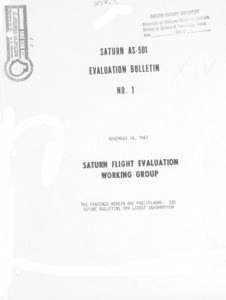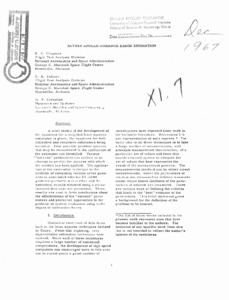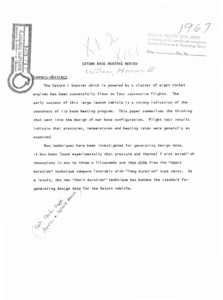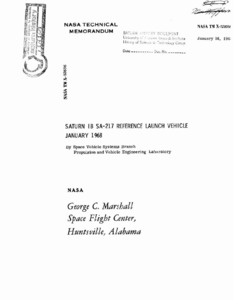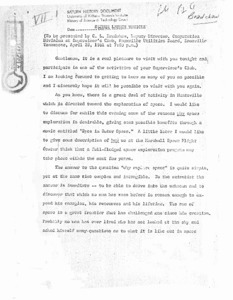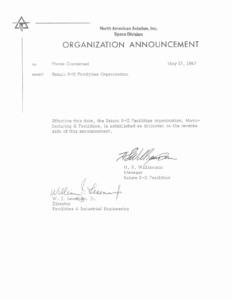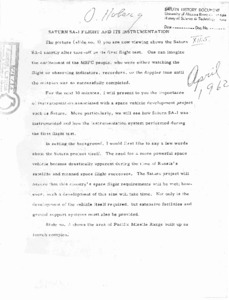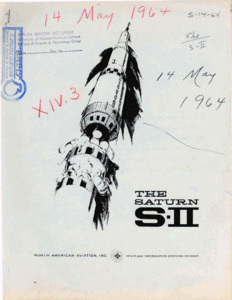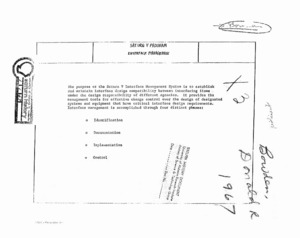
Browse Items (970 total)
Sort by:
-
Saturn AS-501 evaluation bulletin No. 1, November 14, 1967.
The findings herein are the results of the combined evaluation efforts of the various Laboratories of Research and Development Operations at MFSC, The Boeing Company, North American Rockwell/Space Division, Douglas Aircraft Company, International Business Machines, and Rocketdyne. -
Saturn and lunar flight.
Speech by K.K. Dannenberg at American Society of Civil Engineers, Huntsville, November 2.; Projectionist's copy (photocopy) - slide numbers are included. -
"Saturn Apollo guidance error estimation."
A brief sketch of the development of the equations for a weighted least squares estimator is given, the equations for both collective and recursive estimators being included. Four possible problem sources that may be encountered in the application of the estimator are identified. Various "success" parameters are defined in an attempt to predict the success with which, the method has been applied. The application of the estimation technique to the problem of computing various error parameters associated with the ST-124M guidance platform is described with the numerical results obtained using a manufactured data case are presented. These results are used to form conclusions about the effectiveness of the "success" parameters and preferred approaches to the problem of system evaluation using techniques of estimation theory. -
"Saturn base heating review."
The Saturn I booster which is powered by a cluster of eight rocket engines has been successfully flown on four successive flights. The early success of this large launch vehicle is a strong indication of the soundness of its base heating program. This paper summarizes the thinking that went into the design of our base configuration. Flight test results indicate that pressures, temperatures and heating rates were generally as expected. New techniques have been investigated for generating design data. It has been found experimentally that pressure and thermal fields establish themselves in one to three milliseconds and that data from the "short duration" technique compare favorably with "long duration" type tests. As a result, the new "short duration" technique has become the standard for generating design data for the Saturn vehicle. -
"Saturn IB SA-217 reference launch vehicle."
This document contains a definition of a reference Saturn IB launch vehicle designated SA-217. The Saturn IB SA-217 is a projected reference vehicle, based on Saturn IB SA-212, incorporating the latest proposed product improvements. The two-stage payload capability of this vehicle to a 100-nautical-mile circular orbit is 44,965 pounds. The Saturn IB SA-217 launch vehicle is to be used as the baseline vehicle for advanced studies requiring the use of the standard or modified Saturn IB launch vehicle. This vehicle definition does not necessarily represent approved changes to any specific vehicle. This document supersedes the Saturn IB SA-213 reference Launch Vehicle, described in memorandum R-P&VE-DIR-65-92. -
"Saturn launch vehicle presentation."
Speech to be presented by C. L. Bradshaw, Deputy Director, Computation Division at Supervisor's Club, Knoxville Utilities Board. Speech praising the progress of space-based technologies and advancements. -
"Saturn S-II facilities organization."
Organizational chart for the Saturn II facilities. -
"Saturn SA-1 flight and its instrumentation."
Presentation focusing on empahsising the importance of space programs such as Saturn. -
"The Saturn S-II."
The S-II is the second stage of NASA's Apollo moon-landing rocket - the giant Saturn V. The most powerful hydrogen-fueled booster under production, the S-II is destined for Apollo manned lunar missions and will help power three Americans to the moon. The S-II is being developed and manufactured at Seal Beach, Calif., by North American's Space and Information Systems Division, Downey, Calif., under the technical direction of NASA's Marshall Space Flight Center, Huntsville, Ala. -
"Saturn V interface management."
The purpose of the Saturn V Interface Management System is to establish and maintain interface design compatibility between interfacing items under the design responsibility of different agencies. It provides the management tools for effective change control over the design of designated systems and equipment that have critical interface design requirements.
